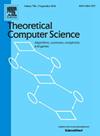Harmonious colourings of temporal matchings
IF 1
4区 计算机科学
Q3 COMPUTER SCIENCE, THEORY & METHODS
引用次数: 0
Abstract
Graph colouring is a fundamental problem in computer science, with a large body of research dedicated to both the general colouring problem and restricted cases. Harmonious colourings are one such restriction, where each edge must contain a globally unique pair of colours, i.e. if an edge connects a vertex coloured x with a vertex coloured y, then no other pair of connected vertices can be coloured x and y. Finding such a colouring in the traditional graph setting is known to be NP-hard, even in trees. This paper considers the generalisation of harmonious colourings to Temporal Graphs, specifically -Temporal matchings, a class of temporal graphs where the underlying graph is a matching (a collection of disconnected components containing pairs of vertices), each edge can appear in at most t timesteps, and each timestep can contain at most k other edges. We provide a complete overview of the complexity landscape of finding temporal harmonious colourings for -matchings. We show that finding a Temporal Harmonious Colouring, a colouring that is harmonious in each timestep, is NP-hard for (k,t)-Temporal Matchings when , or when and . We further show that this problem is inapproximable for and an unbounded value of k, and that the problem of determining the temporal harmonious chromatic number of a -temporal matching can be determined in linear time. Finally, we strengthen this result by a set of upper and lower bounds of the temporal harmonious chromatic number both for individual temporal matchings and for the classes of -temporal matchings, paths, and cycles.
时间搭配的和谐色彩
图形着色是计算机科学中的一个基本问题,有大量的研究致力于一般着色问题和限制情况。和谐着色就是这样一种限制,其中每条边必须包含一个全局唯一的颜色对,即如果一条边连接一个顶点的颜色为x和顶点的颜色为y,那么没有其他连接的顶点对可以为x和y着色。在传统的图设置中找到这样的着色是已知的np困难的,即使在树中也是如此。本文考虑了调和着色对时间图的推广,特别是(k,t)-时间匹配,这是一类时间图,其中底层图是一个匹配(包含对顶点的不连接分量的集合),每个边最多可以在t个时间步中出现,并且每个时间步最多可以包含k个其他边。我们提供了寻找(k,t)-匹配的时间和谐着色的复杂性景观的完整概述。我们发现,当k≥2,t≥4,或k≥3,t≥2时,对于(k,t)-Temporal匹配,寻找一个时间和谐着色,即在每个时间步长都是和谐的着色,是np困难的。进一步证明了该问题对于t≥2和k的无界值是不可逼近的,并且确定(2,3)-时间匹配的时间和谐色数问题可以在线性时间内确定。最后,我们通过单个时间匹配和(k,t)-时间匹配、路径和循环类的时间和谐色数的上界和下界来加强这一结果。
本文章由计算机程序翻译,如有差异,请以英文原文为准。
求助全文
约1分钟内获得全文
求助全文
来源期刊

Theoretical Computer Science
工程技术-计算机:理论方法
CiteScore
2.60
自引率
18.20%
发文量
471
审稿时长
12.6 months
期刊介绍:
Theoretical Computer Science is mathematical and abstract in spirit, but it derives its motivation from practical and everyday computation. Its aim is to understand the nature of computation and, as a consequence of this understanding, provide more efficient methodologies. All papers introducing or studying mathematical, logic and formal concepts and methods are welcome, provided that their motivation is clearly drawn from the field of computing.
 求助内容:
求助内容: 应助结果提醒方式:
应助结果提醒方式:


